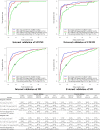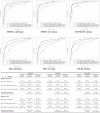Artificial intelligence algorithm for detecting myocardial infarction using six-lead electrocardiography
- PMID: 33235279
- PMCID: PMC7686480
- DOI: 10.1038/s41598-020-77599-6
Artificial intelligence algorithm for detecting myocardial infarction using six-lead electrocardiography
Abstract
Rapid diagnosis of myocardial infarction (MI) using electrocardiography (ECG) is the cornerstone of effective treatment and prevention of mortality; however, conventional interpretation methods has low reliability for detecting MI and is difficulty to apply to limb 6-lead ECG based life type or wearable devices. We developed and validated a deep learning-based artificial intelligence algorithm (DLA) for detecting MI using 6-lead ECG. A total of 412,461 ECGs were used to develop a variational autoencoder (VAE) that reconstructed precordial 6-lead ECG using limb 6-lead ECG. Data from 9536, 1301, and 1768 ECGs of adult patients who underwent coronary angiography within 24 h from each ECG were used for development, internal and external validation, respectively. During internal and external validation, the area under the receiver operating characteristic curves of the DLA with VAE using a 6-lead ECG were 0.880 and 0.854, respectively, and the performances were preserved by the territory of the coronary lesion. Our DLA successfully detected MI using a 12-lead ECG or a 6-lead ECG. The results indicate that MI could be detected not only with a conventional 12 lead ECG but also with a life type 6-lead ECG device that employs our DLA.
Conflict of interest statement
KHJ, KHK, JRMI, SYL, and BHO declare no competing interests. JK and JP are co-founder and stakeholder in Medical AI Co., a medical artificial intelligence company. YC, JK, and SC is researcher of Body friend Co. There are no products in development or marketed products to declare. This dose not alter our adherence to Scientific Reports.
Figures






References
Publication types
MeSH terms
LinkOut - more resources
Full Text Sources
Other Literature Sources
Medical

